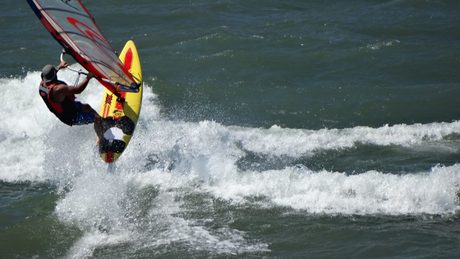|
|
Bio - Eric L. Mihelbergel is an intermediate/advanced windsurfer, kiteboarder, and foiler living in the Great Lakes Region of New York State who enjoys sharing about windsports and fitness.
|
Repairing Your Own Boards
By Eric Mihelbergel (Written 2017)
|
Sooner or later we are all bound to put a hole in a windsurfing board. Maybe the board ends up on the rocks, or maybe the sail falls during a jibe and the mast cracks the board. If you take your board to a professional there are 2 problems. First, it is expensive. You can probably repair it yourself. Second, and more importantly, it can keep you off the water for several days or even weeks if the professional is busy. Learn to do it yourself.
There are 2 scenarios of board repair: 1.) On site repair, so that you can get back on the water while still at the beach, and 2.) At home repair, so you have a solid, long-lasting repair for the life of the board. On Site Repair: Put together a little board repair kit and leave it in your vehicle. You don't need much. If you put a hole in your board and want to keep riding the same day then you are really just looking to make the hole water proof. All you really need is a piece of sand paper, a rag for cleanup, and a tube of Solarez. Sand the area around the hole, clean it, and then just fill it with Solarez or similar product. Solarez cures from ultra-violet radiation (sunlight). Apply the Solarez in the shade because it sets up pretty quick. Use a stick to work the Solarez into the hole or crack, and then put it in the sun for about 15 minutes to cure. If the sky is cloudy it might take a little longer, but it will still cure. It will likely be a little sharp once it hardens so be sure to sand it once it cures and before you ride it. At Home Repair: This will take a little more work, but it's not bad. You will need a power sander. I use a battery powered corner sander. I like the point on the end to get into holes/cracks. Sand out the hole/crack pretty good. You might need to go down as far as the foam if the hole/crack is deep. That's ok. Then start cutting fiberglass pieces to fit the hole. If the hole is deep you may need many layers of fiberglass. The first pieces will generally be small, and you will generally make the pieces wider as the layers get higher. Once you have sufficiently built up the layers then pour on your epoxy resin. I use West System Epoxy, but there are other brands as well. If you have sanded down to the foam then I suggest cutting out a very small piece of the foam and test a drop of the epoxy resin on it. Some epoxy resins can eat certain types of foam, so it's worth testing to make sure it's safe. And don't pour on too much resin at one time because it gets pretty hot and can melt the foam. Let the resin cure according to the directions, and then sand it flush with the rest of the board. If you want to make it pretty then you might need to add another thin layer of resin after you sand in order to smooth out the surface. Then sand again after it cures. Always make sure the board is very clean before applying resin. You can paint it afterwards if you want. Regular spray paints work fine. Use masking tape to make geometric shapes over your repair so that it looks somewhat cool, or just leave it raw if you don't care how it looks. That's it! It really is not difficult. After the second crack that I put in a board I learned how to repair my own stuff. It just took too long to take the board to a professional, and it was expensive. As you become a better windsurfer you will have fewer repairs, but when I was a beginner I broke a lot of boards a lot of times. It was so bad that when I bought a new board I would fiberglass reinforce the nose before I even put the board in the water. I don't do nearly as many repairs now, but sometimes just setting the board on a pointy rock on the beach can punch a hole in the board. Learn to fix those yourself. It's not difficult. |
|

